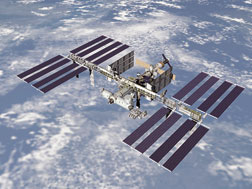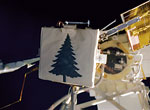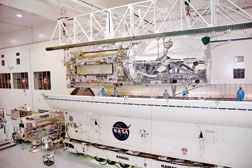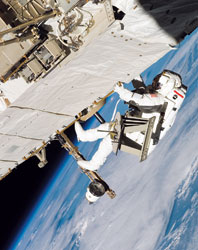 |
|
Dragonfly. Finished width is 356 ft. Astronauts “topped off” work in December 2000. (Photos above below left courtesy of NASA) |
The destination is the highest construction site ever, the partially built ISS. The shuttle that intercepts it will carry a huge load of materials, as well as the astronauts who have been trained to be the erectors, plumbers, electricians and quality assurance technicians installing the next addition to the station.
 |
“Our robotic arms are cranes, we are maneuvering large 10,000, 15,000, 20,000-pound structures and we are attaching them, bolting them into place, doing wiring, and plumbing—that sounds a lot like construction to me,” says NASA astronaut and veteran of two Space Station missions, Col. William S. McArthur Jr., U.S. Army (Ret.). McArthur returned from his most recent, six-month stay at the station on April 8. “In its very current configuration, which is extremely impressive, you look at it and realize that we have had a lot of people contributing small parts to create something that is truly awe-inspiring.”
“It’s about 50% completed by weight and 40% completed by volume,” says Joy Bryant, vice president and ISS program manager for prime contractor Boeing, Co., Chicago. She says the project is a validation lab for elements of construction and processes that will be needed in space construction on the moon and Mars. Whether the ISS will play a role as a stage for low-earth orbit assembly of elements for structures on other worlds “has not been determined,” she says.
|
The process of building out the international space station in modular segments, many built by international partners at a total cost that could exceed $100 billion, is daunting. “Imagine trying to add a floor to your operating building, all at once and every fitting has to line up and be connected,” says Daniel Motto, lead engineer in the astronaut tools division of Swales Aerospace, Beltsville, Md. Swales makes many of the astronauts’ hand tools. “We design a lot of standard tools for making those connections. When the engineers design themselves into a corner, we are a one-off creation house,” he says.
“It takes a tremendous amount of training to turn astronauts into construction workers,” adds Paul O. Smith, a Boeing manager who worked for two decades on space station development and the coordination of international collaboration on the design, engineering and fabrication. He says the ratio of astronaut training time to spacewalk time, or Extra-Vehicular Activity hours, is often 15:1.
“That tends to be what it ends up, although we start off with seven hours if it’s a relatively simple EVA,” confirms Karina Shook, an EVA trainer at Johnson Space Center in Houston. There the astronauts practice construction in a 102x 202x40-ft-deep pool. The water simulates neutral buoyancy, if not weightlessness. Shook says planning is a challenge, because of limitations imposed by the environment and pressurized suits, which weigh about 500 lb with astronaut, life support and tool belt on board. “We get a list of tasks and work with the engineer who built the hardware, the safety engineer and the astronauts, to create a timeline,” says Shook. “We develop the script.”
And then there is the need for astronauts in zero gravity to match every action with a reactive brace and to pace every gesture in slow motion, so that inertia does not carry them away. “On the last mission, one of the tool boxes weighed 330 lb, but it was pretty easy for one astronaut to handle,” says Shook. But another 1,400-lb box had to be picked up from either side and lifted for the robotic arm to grab. It worked, but if the device hadn’t been able to take it one of the astronauts would have had to stand on the robotic arm carrying it in his hands. “It shouldn’t be a lot of muscle. It’s more about keeping it moving slowly so you don’t overdo it and have to use a lot of muscle to get it to stop,” Shook says.
 |
| Laydown. At the Kennedy Space Flight Center, the P3/P4 trusses are packed for late August launch. |
The mission of the August flight is to hoist and install a pair of joined contraptions known as the integrated Port 3 and 4 Truss Structures, or P3/P4. For launch they are tucked into the cargo bay as a 17.4-ton, compacted, folded, and telescoped, hexagonally-shaped mass. They have a complex, rotating electrical connection between them and are crammed with brackets, fittings, platforms and equipment made from aluminum and stainless steel. They house cables, tubes, electrical harnesses and radiators and solar cell panels folded like Japanese fans. Much is swaddled with 20-layer blankets of space fabric and mylar insulation, cut, sewn and laced in place like old-time clipper sails.
 |
|
|
The package in its compacted, launch-mode is 43.5 ft long x 16 ft wide x 15.6 ft high, but with installation it will vastly expand. After the astronauts mate it to the structure, install brace beams and make hose and electrical connections, engineers will command it to raise a telescoped mast and unfurl a pair of 38-ft-wide x 115-ft-long solar-cell wings until they stretch 240 ft from side to side.
Installing P3/P4 is a step in a process built on decades of work by scientists, designers, engineers, fabricating contractors and space flight experts. The actual labor of operating the crane—the shuttle’s robotic arm—to lift the assembly from the cargo bay and lock it into place, will be in the hands of its astronaut operator. But the operator must coordinate with space walkers who will crawl across the frame, pulling themselves from grab bar to hand strap, foot rest to toe hold, focusing on never letting go, but aligning, fastening, connecting and testing all the way.
The August mission picks up a construction schedule put on hold after Space Shuttle Columbia disintegrated during re-entry on Feb. 1, 2003, killing its seven astronauts. The first task of the recent July 4 mission was to prepare the jobsite to resume construction.
The Project
NASA was given the mission to build the ISS by President Ronald Reagan in 1984. Years of concept development, organizing, designing and engineering followed. Boeing won the role of prime contractor in 1993, making it responsible for design, development, construction and integration. It works with 16 international partners and oversees thousands of subcontractors and 10,000 suppliers. The first physical integration of their contributions often occurs in orbit.
The first module was launched in 1998. The ISS has been occupied continually since November 2000. It is scheduled for completion in 2010, after an assembly sequence of 100 major components, almost 50 shuttle missions, 160 spacewalks and 1,920 hours of EVA labor.
“The project has been one of large-scale system integrations in an international engineering and construction effort,” says Smith. “The first question was: ‘Can we build that design?’” he said in an interview two weeks before construction was frozen by the Columbia disaster. By then Smith was coordina-
tor of international support, which became more complicated after the Clinton administration directed NASA to internationalize the project. “The idea was to lessen the burden,” says Alex Pest, Smith’s colleague and then senior manager for ISS structures and mechanisms.
“The capability we’ve got in orbit is spectacular,” Smith says, pointing to redundancies and high-fault tolerances in all major functions. “By going international, we were able to end up with a Cadillac instead of a Ford.”
The ground crew at the Kennedy Space Flight Center in Florida has now gathered all remaining components of the ISS in one building. They use laser scans of mating faces to confirm fit between assemblies, but there are many
other connections, such as threaded sockets, electrical plugs and hoses that must be made without fail. “It’s a pretty bad day when things don’t fit, even down to the thread pitch,” says Pest.
“We would love to have a ‘hangar queen,’ a second space station, but the construction would be enormous,” adds Smith. Instead, every element is...
t the end of this month, if all goes well, Space Shuttle Atlantis will roar into the sky, accelerating to 17,500 mph in eight minutes and crushing its passengers and cargo with a weight three times surface gravity. Then it will slip into weightlessness and begin chasing the International Space Station, orbiting 220 miles above the globe. Related Links:
Related Links: 
Post a comment to this article
Report Abusive Comment